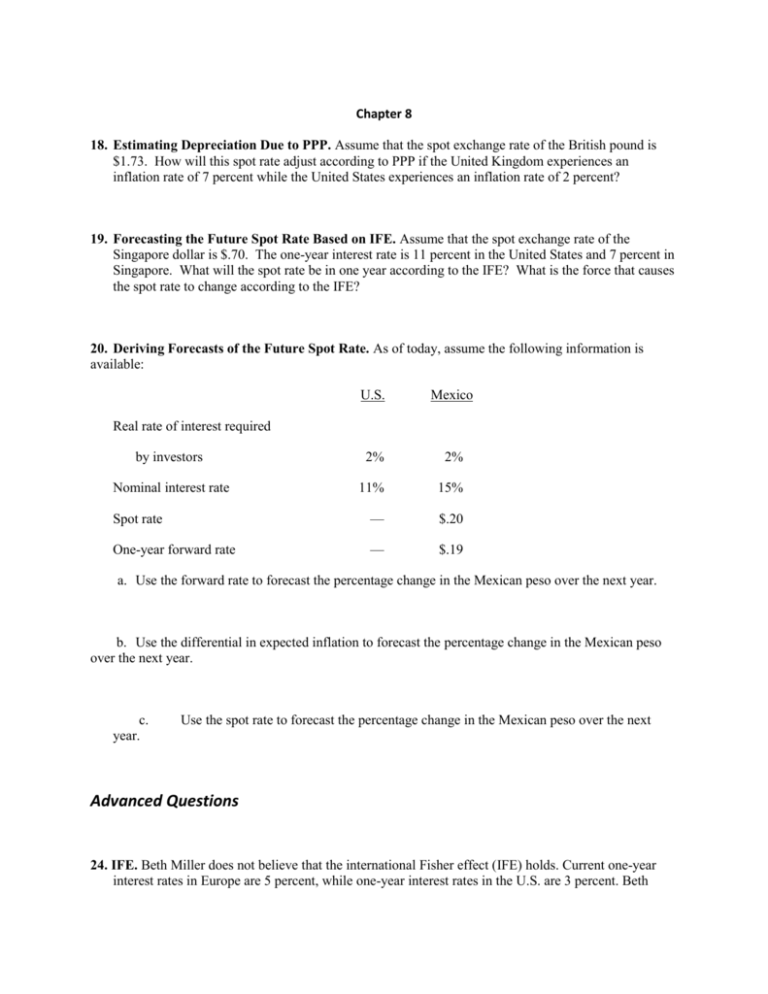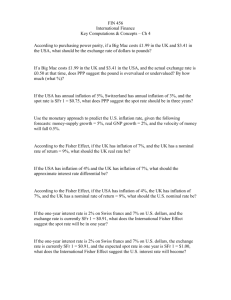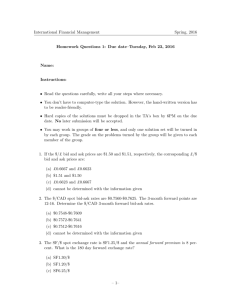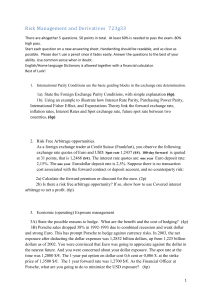Chapter_8_FINA_4315
advertisement

Chapter 8 18. Estimating Depreciation Due to PPP. Assume that the spot exchange rate of the British pound is $1.73. How will this spot rate adjust according to PPP if the United Kingdom experiences an inflation rate of 7 percent while the United States experiences an inflation rate of 2 percent? 19. Forecasting the Future Spot Rate Based on IFE. Assume that the spot exchange rate of the Singapore dollar is $.70. The one-year interest rate is 11 percent in the United States and 7 percent in Singapore. What will the spot rate be in one year according to the IFE? What is the force that causes the spot rate to change according to the IFE? 20. Deriving Forecasts of the Future Spot Rate. As of today, assume the following information is available: U.S. Mexico by investors 2% 2% Nominal interest rate 11% 15% Spot rate — $.20 One-year forward rate — $.19 Real rate of interest required a. Use the forward rate to forecast the percentage change in the Mexican peso over the next year. b. Use the differential in expected inflation to forecast the percentage change in the Mexican peso over the next year. c. year. Use the spot rate to forecast the percentage change in the Mexican peso over the next Advanced Questions 24. IFE. Beth Miller does not believe that the international Fisher effect (IFE) holds. Current one-year interest rates in Europe are 5 percent, while one-year interest rates in the U.S. are 3 percent. Beth converts $100,000 to euros and invests them in Germany. One year later, she converts the euros back to dollars. The current spot rate of the euro is $1.10. a. According to the IFE, what should the spot rate of the euro in one year be? b. If the spot rate of the euro in one year is $1.00, what is Beth’s percentage return from her strategy? c. If the spot rate of the euro in one year is $1.08, what is Beth’s percentage return from her strategy? d. What must the spot rate of the euro be in one year for Beth’s strategy to be successful? 25. Integrating IRP and IFE. Assume the following information is available for the U.S. and Europe: U.S. Europe Nominal interest rate 4% 6% Expected inflation 2% 5% Spot rate ----- $1.13 One-year forward rate ----- $1.10 a. Does IRP hold? b. According to PPP, what is the expected spot rate of the euro in one year? c. According to the IFE, what is the expected spot rate of the euro in one year? d. Reconcile your answers to parts (a). and (c). 26. IRP. The one-year risk-free interest rate in Mexico is 10%. The one-year risk-free rate in the U.S. is 2%. Assume that interest rate parity exists. The spot rate of the Mexican peso is $.14. a. What is the forward rate premium? b. What is the one-year forward rate of the peso? c. Based on the international Fisher effect, what is the expected change in the spot rate over the next year? d. If the spot rate changes as expected according to the IFE, what will be the spot rate in one year? e. Compare your answers to (b) and (d) and explain the relationship. 32. Arbitrage and PPP. Assume that locational arbitrage ensures that spot exchange rates are properly aligned. Also assume that you believe in purchasing power parity. The spot rate of the British pound is $1.80. The spot rate of the Swiss franc is .3 pounds. You expect that the one-year inflation rate is 7 percent in the U.K., 5 percent in Switzerland, and 1 percent in the U.S. The one-year interest rate is 6% in the U.K., 2% in Switzerland, and 4% in the U.S. What is your expected spot rate of the Swiss franc in one year with respect to the U.S. dollar? Show your work. 34. IRP, PPP, and Speculating in Currency Derivatives. The U.S. three-month interest rate (unannualized) is 1%. The Canadian three-month interest rate (unannualized) is 4%. Interest rate parity exists. The expected inflation over this period is 5% in the U.S. and 2% in Canada. A call option with a three-month expiration date on Canadian dollars is available for a premium of $.02 and a strike price of $.64. The spot rate of the Canadian dollar is $.65. Assume that you believe in purchasing power parity. a. Determine the dollar amount of your profit or loss from buying a call option contract specifying C$100,000. b. Determine the dollar amount of your profit or loss from buying a futures contract specifying C$100,000. 35. Implications of PPP. Today’s spot rate of the Mexican peso is $.10. Assume that purchasing power parity holds. The U.S. inflation rate over this year is expected to be 7%, while the Mexican inflation over this year is expected to be 3%. Wake Forest Co. plans to import from Mexico and will need 20 million Mexican pesos in one year. Determine the expected amount of dollars to be paid by the Wake Forest Co. for the pesos in one year. 38. Real Interest Rates, Expected Inflation, IRP, and the Spot Rate. The U.S. and the country of Rueland have the same real interest rate of 3%. The expected inflation over the next year is 6 percent in the U.S. versus 21% in Rueland. Interest rate parity exists. The one-year currency futures contract on Rueland’s currency (called the ru) is priced at $.40 per ru. What is the spot rate of the ru? 39. PPP and Real Interest Rates. The nominal (quoted) U.S. one-year interest rate is 6%, while the nominal one-year interest rate in Canada is 5%. Assume you believe in purchasing power parity. You believe the real one-year interest rate is 2% in the U.S, and that the real one-year interest rate is 3% in Canada. Today the Canadian dollar spot rate at $.90. What do you think the spot rate of the Canadian dollar will be in one year? 40. IFE, Cross Exchange Rates, and Cash Flows. Assume the Hong Kong dollar (HK$) value is tied to the U.S. dollar and will remain tied to the U.S. dollar. Assume that interest rate parity exists. Today, an Australian dollar (A$) is worth $.50 and HK$3.9. The one-year interest rate on the Australian dollar is 11%, while the one-year interest rate on the U.S. dollar is 7%. You believe in the international Fisher effect. You will receive A$1 million in one year from selling products to Australia, and will convert these proceeds into Hong Kong dollars in the spot market at that time to purchase imports from Hong Kong. Forecast the amount of Hong Kong dollars that you will be able to purchase in the spot market one year from now with A$1 million. Show your work. 41. PPP and Cash Flows. Boston Co. will receive 1 million euros in one year from selling exports. It did not hedge this future transaction. Boston believes that the future value of the euro will be determined by purchasing power parity (PPP). It expects that inflation in countries using the euro will be 12% next year, while inflation in the U.S. will be 7% next year. Today the spot rate of the euro is $1.46, and the one-year forward rate is $1.50. a. Estimate the amount of U.S. dollars that Boston will receive in one year when converting its euro receivables into U.S. dollars. b. Today, the spot rate of the Hong Kong dollar is pegged at $.13. Boston believes that the Hong Kong dollar will remain pegged to the dollar for the next year. If Boston Co. decides to convert its 1 million euros into Hong Kong dollars instead of U.S. dollars at the end of one year, estimate the amount of Hong Kong dollars that Boston will receive in one year when converting its euro receivables into Hong Kong dollars. 42. PPP and Speculating with Currency Futures. Assume that you believe purchasing power parity (PPP) exists. You expect that inflation in Canada during the next year will be 3%, and inflation in the U.S. will be 8%. Today the spot rate of the Canadian dollar is $.90 and the one-year futures contract of the Canadian dollar is priced at $.88. Estimate the expected profit or loss if an investor sold a oneyear futures contract today on one million Canadian dollars and settled this contract on the settlement date. 43. PPP and Changes in the Real Interest Rate. Assume that you believe exchange rate movements are mostly driven by purchasing power parity. The U.S. and Canada presently have the same nominal (quoted) interest rate. The central bank of Canada just made an announcement that causes you to revise your estimate of Canada’s real interest rate downward. Nominal interest rates were not affected by the announcement. Do you expect that the Canadian dollar to appreciate, depreciate, or remain the same against the dollar in response to the announcement? Briefly explain your answer. A decrease in the real interest rate (with no change in the nominal interest rate) means that Canada’s expected inflation rate is increased. This new information causes an expected decrease in U.S. demand for Canadian dollars and/or an increased supply of Canadian dollars to be exchanged for U.S. dollars (due to international trade with the U.S.), which results in a weaker Canadian dollar. 44. IFE and Forward Rate. The one-year Treasury (risk-free) interest rate in the U.S. is presently 6%, while the one-year Treasury interest rate in Switzerland is 13%. The spot rate of the Swiss franc is $.80. Assume that you believe in the international Fisher effect. You will receive 1 million Swiss francs in one year. a. What is the estimated amount of dollars you will receive when converting the francs to U.S. dollars in one year at the spot rate at that time? b. Assume that interest rate parity exists. If you hedged your future receivables with a one-year forward contract, how many dollars will you receive when converting the francs to U.S. dollars in one year? 45.PPP. You believe that the future value of the Australian dollar will be determined by purchasing power parity (PPP). You expect that inflation in Australia will be 6% next year, while inflation in the U.S. will be 2% next year. Today the spot rate of the Australian dollar is $.81, and the one-year forward rate is $.77. What is the expected spot rate of the Australian dollar in one year?






